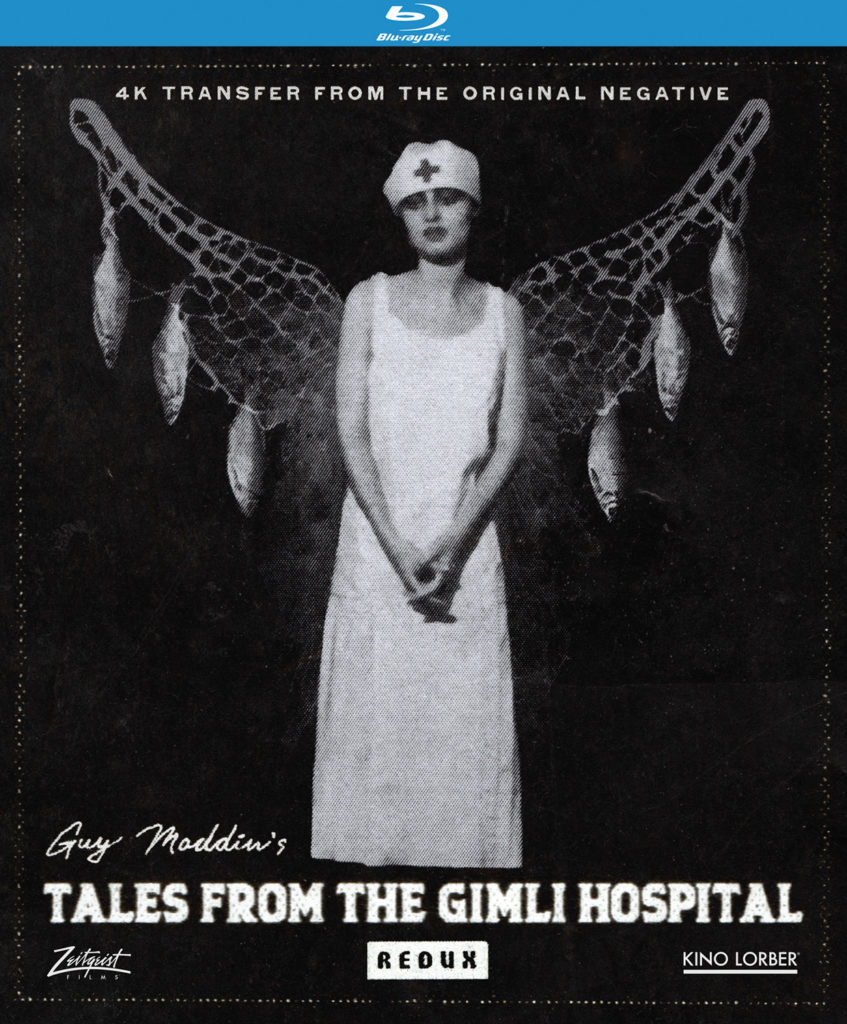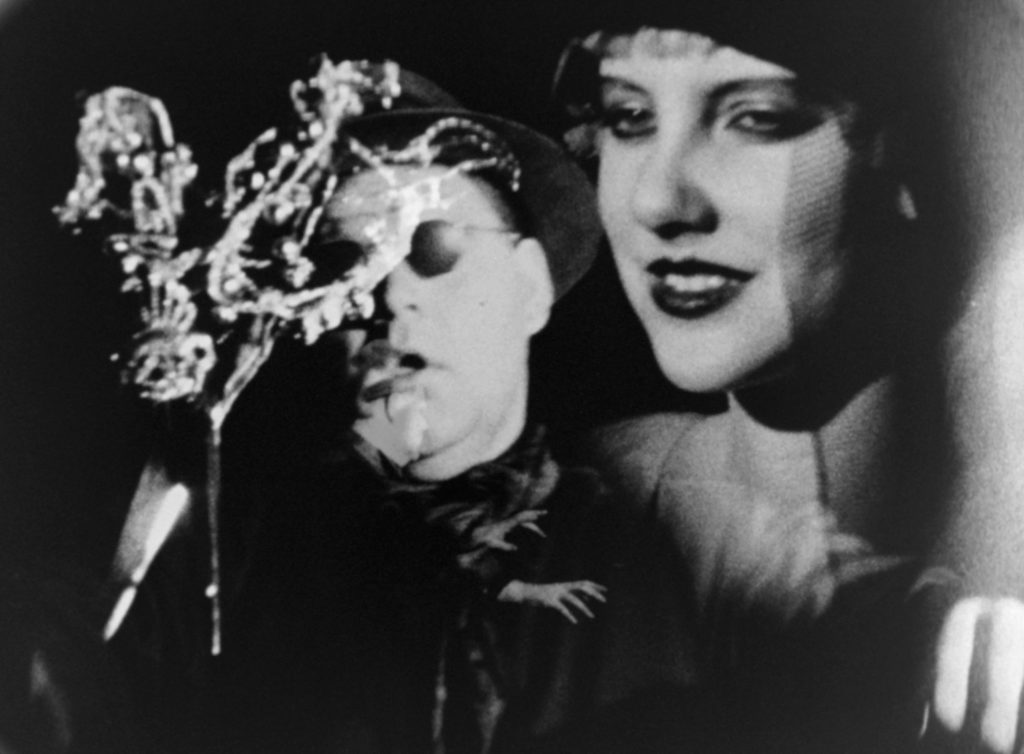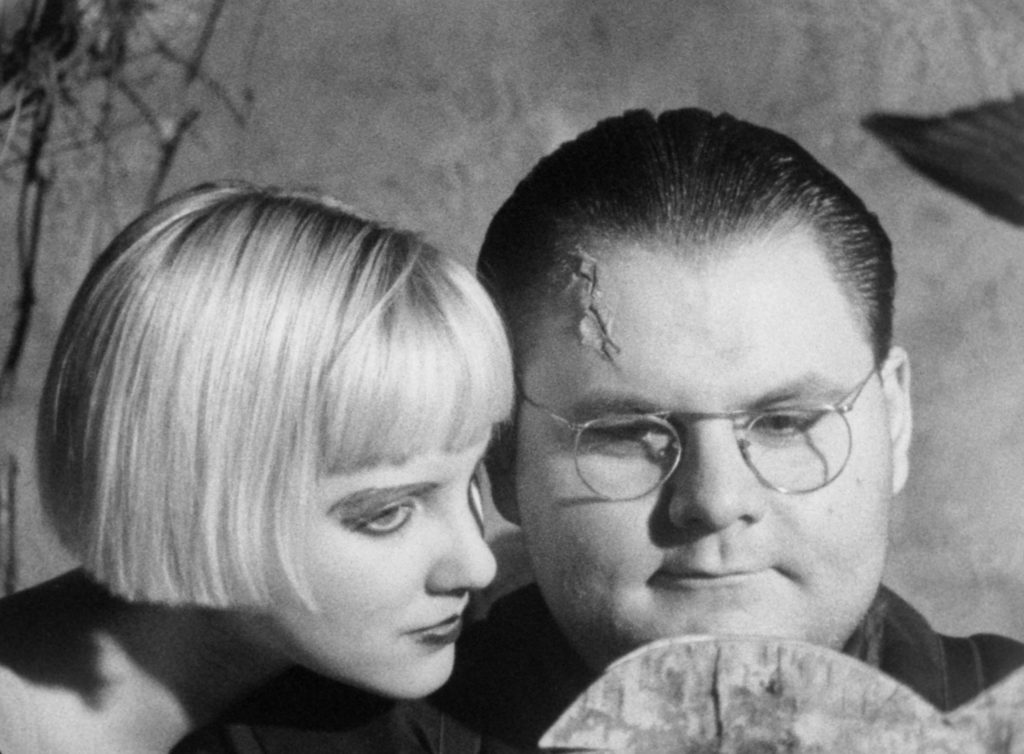Purple Or Perhaps Magenta Visions Of Regional Discontent And Folk Madness, Revived Or More Accurately Reduxed After 34 Years
DIRECTED BY GUY MADDIN/CANADA
STREET DATE: JUNE 20TH, 2023/ZEITGEIST FILMS & KINO LORBER

Arriving with more than just tongue-in-cheek in a “redux” 4K remastering, Guy Maddin’s first feature completes its journey from a 16mm-shot independent production to a midnight movie-distributed cult favorite to finally a digitally-transferred reworking with the replacement of a “lost scene”. That the scene in question was actually shot 11 years after the original filming, and that this new version runs about four minutes shorter than the originally-released film, are questions I’ll address at the end of the review, but for the meanwhile of this introduction, Tales from the Gimli Hospital, Redux or otherwise, has always seemed to exist amorphously in the viewing imaginations of those who have, or even haven’t, seen it. Set in a “Gimli we no longer know”, historically a settlement outside the Canadian province of Manitoba, populated by Icelandic refugees fleeing a late 1860s volcanic eruption, the additionally historical, 1870s smallpox epidemic that loosely inspires the “story” here told, such as it is, becomes a mere framework for visions, dreams, hallucinations, and frankly unclassifiable “other” visual passages that shift, swirl, and superimpose upon themselves with the persistent force of repressed memories, imperfectly remembered.
Playing like a lost film artifact improperly projected on faulty equipment, the tangled skein of myths, legends, and real history arise from a vaguely late-1920s-seeming evocation of silent film being at times violently overtaken by sound; the hybrid artistic product, the very tension of its melodramatic form, resulting in just over 60 minutes of compressed but never less than compelling audio-visual nightmare. As introduction to the work of Guy Maddin, a former house-painter who significantly includes one musical-fantasy sequence in purple, or more properly magenta, with his otherwise monochrome visions of regional discontent and folk madness, the more ambiguously redux-ed version some three-and-a-half decades after offers a new view of old dreams.

Descending from elaborately-winged angels on clouds to Gimli and its hospital as we may “now” know it, with its revving muscle-cars, super big-gulp soft drinks, and punk rock-riffs blaring over the radio, a traditionally-dressed Icelandic grandmother comforts her small grandson and granddaughter by the bedside of their dying mother with tales of a Gimli Hospital that “was”. Stretching back across time, myth, memory, and history, the film opens a rustic window on a bright morning long past as young, supple men and women are shown preparing themselves for the day; rubbing straw on their handsome faces, spreading dirt on their lean bellies, and running out to display their scantily-clad bodies on the beach. One Einar the Lonely (Kyle McCulloch) groggily emerges from his fishing hut and upon spying the symmetrical rows of bathing beauties just outside is soon made ashamed of his unkempt hair. Quickly retreating behind his hut, Einar squeezes out oil from the guts of a fish nailed to his shack and liberally applies the goo to slick back his hair in a more pleasing coiffure. Alas, the grooming effort comes to naught as the first woman he encounters later that evening screams in horror at the telltale sign of The Plague running scar-like down his cheek.
Collapsing through the admissions door of the Gimli Hospital, more a barn or storage-shed erected over an animal pasture, Einar takes his place among the more sickly rows of straw beds, the hanging tangles of white bed-sheets, and clouds of floating pillow feathers; all constituting a glorified makeshift quarantine. Amongst sickness, blood-letting, scarring, and operations performed with only puppet shows for anesthetic, Einar finds initial comfort in his affable neighbor Gunnar (Michael Gottli), a gregarious story-teller who inspires Einar with his passionate hobby of bark-fish cutting and bark-fish appreciation, but Einar subsequently becomes jealous and even angry over his friend-rival Gunnar’s easy-going ways; especially the more outgoing patient’s ease with the comely and heavily mascaraed staff of nurses. With the revelation of a terrible, secret past-association between them involving a previously unknown tragedy with Gunnar’s dead wife Snjófridur (Anne Macleod), the fevers, disfigurements of the disease, and symptoms both physical and psychological increase, resulting in a delirium where nightmares and hallucinations merge to become one; finding Einar and Gunnar, one blind and the other insane, stumbling towards each other in the shadow-soaked darkness. Penultimately clashing in a butt-grappling wrestling-match on the frozen winter ground, their pants, flesh, and plague-scars mutually rip and tear as the terrible male rivalry reaches its blood-soaked (ir)resolution.

The imagination of Guy Maddin is a singular place to visit for just over an hour, and fortunately he became a filmmaker so we can best appreciate the many forms it would take over the next three-and-a-half decades. Developing the dramatic displacement and antique surreal atmosphere of his first short film, 1985’s The Dead Father, in which a mourning son receives several posthumous visitations from his deceased father in “The Dominion of Forgetfulness”, that filmic space between dream, reality, and someplace not quite either is here expanded and developed upon with the sheer inventiveness of a cosmonaut of the mind fearlessly exploring the unconscious. Seemingly sprung fully formed from the id, with no mitigating superego, but seasoned with a bracing dash of ego, the techniques of silent films – including color filters and gels, expressionistic set-design, rhythmic editing, in-camera superimpositions and phantasmagoric image-layering – clash against tinny, equally-layered soundtrack distortions – fuzzy “blankets of sound” – to create an aesthetic that seemingly once Was, but has in fact Never Been.
With Tales from the Gimli Hospital, the real and the unreal co-exist to the point where they are mutually indistinguishable. A catalog of randomly described moments and settings include the buckets of milk spilled over a fire on a roof dripping down to bed-ridden Gunnar below, the animal pasture of lowing cows and bleating sheep moving and shifting impatiently beneath the straw hospital beds, and even the trio of nurses gathering and writhing in suggestive embrace over the recently dug grave of a lost patient; which all in fact have basis in actual history or real memory. Combining strategies of the avant-garde with old Hollywood conventions of plotting and character, the stories unfold with just enough causal sense, along with emotions we can vaguely relate to, to more deeply involve us viewers with the otherwise more shocking and even transgressive assaults on normal or familiar assumptions of narrative filmmaking.
One sequence particularly illustrative of the above, and one which appears to its hitherto best advantage in this Redux version, is the lead-up to the climactic ass-grabbing contest in which Einar, mad and delirious, and Gunnar, blind and stumbling through the wilderness, are each individually lost in imagined reveries of revenge and sexual ecstasy, respectively. Einar, peering through a branch-strewn clearing in the woods, has the aforementioned magenta vision arise before his fevered eyes of a coterie of gooey-gowned lovelies dripping with shining costume jewels, shimmering erotically to a lip-synched, scratchy phonograph tune; while Gunnar, trapped sightlessly in a barn-loft, has more murderous visions attacking his unseeing mind’s eye, multiple non-ocular layers of throttling, choking, and strangling his adversary filling and suffocating the surrounding night air. As the sequence builds, and the levels of reality both subjective and not increase with the visual orgies of rage and lust on visual display, Maddin cross-cuts between fever-dream and hallucinatory nightmare – two entirely imaginary mental states of two different characters – towards the indescribable confrontation between mortal enemies, signaled by a sudden surrounding parade of full-regalia Scottish bag-pipers piercing the Canadian wilderness like a windswept sonic-knife.

I must admit that when I first viewed Tales in the mid-1990s on the original Kino International VHS release, rented from the local Four Star Video Heaven with $3.68 of tip-money earned from my post-high school Pizza Hut delivery job, what made me a lifelong Guy Maddin fan was in fact the passage described above; rewinding and replaying it over and over again until I finally “got” it. Several home video formats later, on this new Blu-ray transfer of the recent 4K remaster which premiered at the Toronto International Film Festival (TIFF) in 2022, the sequence actually appears more effective, the previous visual smear of the original 16mm transfer color-corrected to more clearly denote the purple-magenta musical sex-fantasy from the simultaneous monochrome murder-revenge imagery. As a “redux”, Maddin has additionally taken the opportunity to seamlessly insert the three-minute sequence formerly known as Hospital Fragment (1999). Shot with an ailing Michael Gottli, reprising his role as Gunnar, the restored Fragment appears in the context of the Gimli story when his character is mentally reconstituting the drama of the puppet show unfolding before him as an abstract, fish-and-netting dominated premonition of the violently perverse love-triangle about to unfold in the story-proper, while his character is being operated on without anesthetic.
This redux is, as mentioned, about four minutes shorter than the originally exhibited film, and one imagines the director has used the opportunity to tighten some sequences and to correct what he may now perceive through the distance of years as youthful “mistakes”. While he does not directly address the issue in his new audio commentary, recorded for the Zeitgeist/Kino Lorber Blu-ray, Einar the Lonely actor Kyle McCulloch’s second Tales role as a shamelessly mugging blackface minstrel has been significantly cut to the point of non-appearance in this Redux; except as a corpse with a bed-sheet quickly drawn over his cultural offense. While these sequences’ appearance as “horror relief”, as opposed to comic, in the original 1988 Tales was perhaps satirically intended, a comment on negative racial assumptions exploited in several circa-1930s films for dubious entertainment value, their non-inclusion in the 2022 Redux is, given the current social and political climate, no great loss.
Guy Maddin, as mentioned, has prepared a director’s commentary for this cinematic upgrade and revision, recorded in the Winnipeg-area studio where the original sound-mix of the film was assembled 34 years before. It’s a charming, and charmingly free-associational, feature-length reminiscence on a film made by a much younger version of his present self. The older Maddin, a bit harsh on his younger self, describes the earlier Maddin as stumbling but persevering through the challenges of his first feature as a “confused”, “cowardly”, and sometimes “bit of an asshole” novice/amateur. But if so the evidence of the film suggests those qualities served its two-and-a-half-year production quite admirably. The more richly-described “memory-catalog” that the film has become three-and-a-half decades later – for this literally homemade film, Maddin describes the credits as a “necrology” of old friends and long-past associates; as centrally shot in his favorite relative Aunt Lil’s beauty-salon, shortly before it was sold and his aunt passed away – will give audio-viewers new levels on which to appreciate the film and its production.
Finally, as a bonus feature, Maddin’s 2000-released short film The Heart of the World probably deserves its own separate review, but in short this Soviet montage-style science-fiction epic, running a bit less than seven minutes, not only corrects the historically-maligned conclusion to Fritz Lang’s Metropolis (1927), but in the lead-up to that stunning moment invokes Eisenstein, Abel Gance, and about 110 years of film history in just under one reel. Past his first four features, The Heart of the World provided new direction for the filmmaker – where previously he had focused on composition and mise-en-scene, his still recognizable style and aesthetic more deliberately focused afterward on editing – and paired here with this thirty-four-year-later Redux of his first feature shows how these deceptively aimless and strikingly intuitive qualities persisted through his highly imaginative efforts thereafter. Guy Maddin-land, then and now, redux-ed or otherwise, remains a great place to visit and indeed re-visit.
Images in this review are taken from a variety of sources as a visual reference and do not represent the image quality of this Blu-ray.

